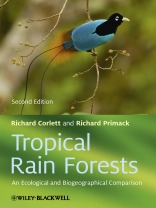The first edition of Tropical Rain Forests: an Ecological and
Biogeographical Comparison exploded the myth of ‘the rain
forest’ as a single, uniform entity. In reality, the major
tropical rain forest regions, in tropical America, Africa,
Southeast Asia, Madagascar, and New Guinea, have as many
differences as similarities, as a result of their isolation from
each other during the evolution of their floras and faunas. This
new edition reinforces this message with new examples from recent
and on-going research.
After an introduction to the environments and geological
histories of the major rain forest regions, subsequent chapters
focus on plants, primates, carnivores and plant-eaters, birds,
fruit bats and gliding animals, and insects, with an emphasis on
the ecological and biogeographical differences between regions.
This is followed by a new chapter on the unique tropical rain
forests of oceanic islands. The final chapter, which has been
completely rewritten, deals with the impacts of people on tropical
rain forests and discusses possible conservation strategies that
take into account the differences highlighted in the previous
chapters. This exciting and very readable book, illustrated
throughout with color photographs, will be invaluable reading for
undergraduate students in a wide range of courses as well as an
authoritative reference for graduate and professional ecologists,
conservationists, and interested amateurs.
Biogeographical Comparison exploded the myth of ‘the rain
forest’ as a single, uniform entity. In reality, the major
tropical rain forest regions, in tropical America, Africa,
Southeast Asia, Madagascar, and New Guinea, have as many
differences as similarities, as a result of their isolation from
each other during the evolution of their floras and faunas. This
new edition reinforces this message with new examples from recent
and on-going research.
After an introduction to the environments and geological
histories of the major rain forest regions, subsequent chapters
focus on plants, primates, carnivores and plant-eaters, birds,
fruit bats and gliding animals, and insects, with an emphasis on
the ecological and biogeographical differences between regions.
This is followed by a new chapter on the unique tropical rain
forests of oceanic islands. The final chapter, which has been
completely rewritten, deals with the impacts of people on tropical
rain forests and discusses possible conservation strategies that
take into account the differences highlighted in the previous
chapters. This exciting and very readable book, illustrated
throughout with color photographs, will be invaluable reading for
undergraduate students in a wide range of courses as well as an
authoritative reference for graduate and professional ecologists,
conservationists, and interested amateurs.
Table of Content
Preface to the first edition.Preface to the second edition.
Acknowledgments.
1 Many Tropical Rain Forests.
What are tropical rain forests?
Where are the tropical rain forests?
Rain forest environments.
Rain forest histories.
Origins of the similarities and differences among rain
forests.
Many rain forests.
Conclusions.
2 Plants: Building Blocks of the Rain Forest.
Plant distributions.
Rain forest structure.
How many plant species?
Widespread plant families.
Neotropical rain forests.
Asian rain forests.
Rain forests in New Guinea and Australia.
African rain forests.
Madagascan rain forests.
Conclusions and future research directions.
3 Primate Communities: A Key to Understanding Biogeography
and Ecology.
What are primates?
Old World versus New World primates.
Primate diets.
Primate communities.
Primates as seed dispersal agents.
Conclusions and future research directions.
4 Carnivores and Plant-eaters.
Carnivores.
Herbivores of the forest floor.
Conclusions and future research directions.
5 Birds: Linkages in the Rain Forest Community.
Biogeography.
Little, brown, insect-eating birds.
Forest frugivores.
Fruit size and body size.
Flower visitors.
Ground-dwellers.
Woodpeckers.
Birds of prey.
Scavengers.
Night birds.
Migration.
Comparison of bird communities across continents.
Conclusions and future research directions.
6 Fruit Bats and Gliding Animals in the Forest
Canopy.
Fruit- and nectar-feeding bats.
Flying behavior.
Foraging behavior.
Bats as pollinators and seed dispersal agents.
Gliding vertebrates.
Conclusions and future research directions.
7 Insects: Diverse, Abundant, and Ecologically
Important.
Butterflies.
Ants.
Termites.
Bees.
Conclusions and future research directions.
8 Island Rain Forests.
Pacific islands.
Evolution on islands.
Indian Ocean islands.
Atlantic islands.
Caribbean islands.
Natural disasters.
Human impacts.
Conclusions and future research directions.
9 The Future of Tropical Rain Forests.
Different forests, different threats.
The major threats.
The forces behind the threats.
Global climate change.
Saving the many rain forests.
Conclusions and future research directions.
References.
Index.
About the author
Richard Corlett, a Professor at the National University ofSingapore, has studied tropical rain forests in New Guinea,
Southeast Asia, and southern China. His major current research
interest is in how rain forest plants and animals survive in
human-dominated landscapes. He has previously taught ecology at the
University of Chiang Mai, in Thailand, and the University of Hong
Kong, in China, and is author or co-author of several books on the
ecology of the Asian tropics.
Richard B. Primack, a Professor at Boston University, is
the author of two leading textbooks in conservation biology and is
the Editor in Chief of the journal, Biological Conservation.
He has carried out research in Central America, Malaysia, and
Australia, and is currently studying the impact of climate change
on plant and animal communities. He is a former President of
the Association for Tropical Biology and Conservation.
Language English ● Format PDF ● Pages 356 ● ISBN 9781444392272 ● File size 17.4 MB ● Publisher John Wiley & Sons ● Published 2011 ● Edition 2 ● Downloadable 24 months ● Currency EUR ● ID 2454168 ● Copy protection Adobe DRM
Requires a DRM capable ebook reader











![Cover of [加]史蒂文·厄尔: 地球气候简史 Cover of [加]史蒂文·厄尔: 地球气候简史](https://static.world-of-digitals.com/thumb_webp/226/9798869051226.webp)
